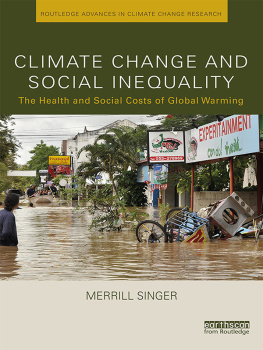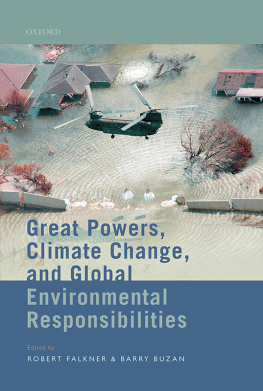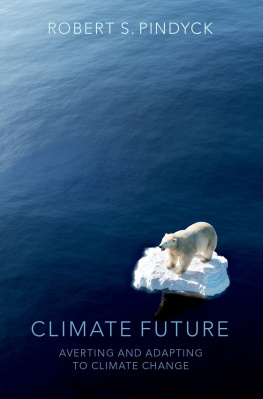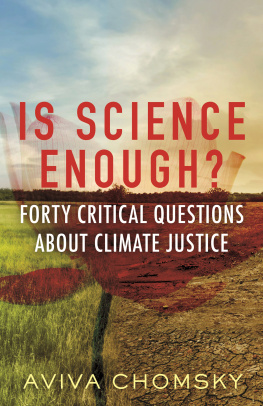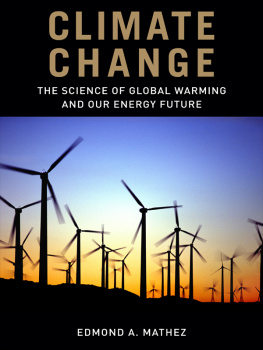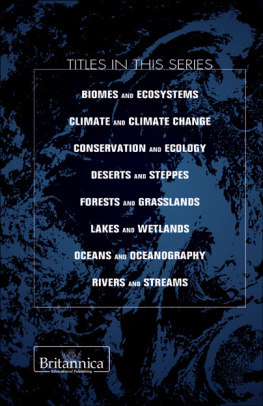CLIMATE CHANGE AND SOCIAL INEQUALITY
The year 2016 was the hottest year on record and the third consecutive recordbreaking year in planet temperatures. The following year was the hottest in a nonEl Nio year. Of the seventeen hottest years ever recorded, sixteen have occurred since 2000, indicating the trend in climate change is toward an ever warmer Earth. However, climate change does not occur in a social vacuum; it reflects relations between social groups and forces us to contemplate the ways in which we think about and engage with the environment and each other.
Employing the experience-near anthropological lens to consider human social life in an environmental context, this book examines the fateful global intersection of ongoing climate change and widening social inequality. Over the course of the volume, Singer argues that the social and economic precarity of poorer populations and communitiesfrom villagers to the urban disadvantaged in both the global North and global South-is exacerbated by climate change, putting some people at considerably enhanced risk compared to their wealthier counterparts. Moreover, the book adopts and supports the argument that the key driver of global climatic and environmental change is the global economy controlled primarily by the worlds upper class, which profits from a ceaseless engine of increased production for national middle classes who have been converted into constant consumers.
Drawing on case studies from Alaska, Ecuador, Bangladesh, Haiti and Mali, Climate Change and Social Inequality will be of great interest to students and scholars of climate change and climate science, environmental anthropology, medical ecology and the anthropology of global health.
Merrill Singer is Professor in the Departments of Anthropology and Community Medicine at the University of Connecticut, USA.
ROUTLEDGE ADVANCES IN CLIMATE CHANGE RESEARCH
The Anthropology of Climate Change
An Integrated Critical Perspective
Hans A. Baer and Merrill Singer
EU Climate Diplomacy
Politics, Law and Negotiations
Edited by Stephen Minas and Vassilis Ntousas
The Global Climate Regime and Transitional Justice
Sonja Klinsky and Jasmina Brankovic
Climate Justice and the Economy
Social Mobilization, Knowledge and the Political
Edited by Stefan Gaarsmand Jacobsen
A Critical Approach to Climate Change Adaptation
Discourses, Policies and Practices
Edited by: Silja Klepp and Libertad Chavez-Rodriguez
Contemplating Climate Change
Mental Models and Human Reasoning
Stephen M. Dark
Climate Change, Moral Panics and Civilization
Amanda Rohloff
Edited by Andr Saramago
Climate Change and Social Inequality
The Health and Social Costs of Global Warming
Merrill Singer
Cities Leading Climate Action
Urban Policy and Planning
Sabrina Dekker
For more information about this series, please visit: https://www.routledge.com/Routledge-Advances-in-Climate-Change-Research/book-series/RACCR
CLIMATE CHANGE AND SOCIAL INEQUALITY
The Health and Social Costs of Global Warming
Merrill Singer
First published 2019
by Routledge
2 Park Square, Milton Park, Abingdon, Oxon OX14 4RN
and by Routledge
711 Third Avenue, New York, NY 10017
Routledge is an imprint of the Taylor & Francis Group, an informa business
2019 Merrill Singer
The right of Merrill Singer to be identified as author of this work has been asserted by him in accordance with sections 77 and 78 of the Copyright, Designs and Patents Act 1988.
All rights reserved. No part of this book may be reprinted or reproduced or utilised in any form or by any electronic, mechanical, or other means, now known or hereafter invented, including photocopying and recording, or in any information storage or retrieval system, without permission in writing from the publishers.
Trademark notice: Product or corporate names may be trademarks or registered trademarks, and are used only for identification and explanation without intent to infringe.
British Library Cataloguing-in-Publication Data
A catalogue record for this book is available from the British Library
Library of Congress Cataloging in Publication Data
A catalog record has been requested for this book
ISBN: 978-1-138-10290-3 (hbk)
ISBN: 978-1-138-10291-0 (pbk)
ISBN: 978-1-315-10335-8 (ebk)
I would like to thank Hans Baer, long-time friend and collaborator, for reading and providing comments on an earlier draft of this book.
The year 2016 was the hottest year on record since measurement began 137 years ago and it was the third consecutive record-breaking year for planet temperatures. The following year was the hottest in a non-El Nino year. Of the 17 hottest years ever recorded, 16 occurred since 2000, indicating the trend in climate change is toward an ever-warmer Earth and most of this change is human-induced, estimated by some scientists to account for as high as 75 percent of rising temperatures. Additionally, in October 2017, the World Meteorological Organization announced that atmospheric concentrations of CO2 increased at a record rate during 2016 and reached their highest point in 800,000 years. The last time there was this much CO2 in the atmosphere, modern humans, like Cro-Magnons (who lived between 3,500 and 10,000 years ago) did not yet exist. The oceans were home to megatoothed sharks, sea levels were 100 feet higher than they are today. It is estimated by climate scientists that Earths global average surface temperature was as much as 11F warmer than it is now and there was comparatively little ice on the planet.
There are two key indicators of the extent of climate change in 2016: rising global surface temperatures and the shrinking extent of Arctic sea ice. Just a few years ago, 2014 was the hottest year on record, but then came 2015, which was hotter still. Now 2016 has broken the record, which for a three-year period is itself a record, an ominous sign of the climatic trend on Earth. In the words of the World Meteorological Organizations (WMO) World Climate Research Program Director, David Carlson, Earth has been pushed into truly unchartered territory (World Meteorological Organization 2017).
In addition to its overall record-breaking temperatures, it is not an overstatement to say that climate change caused disruption all over the world in 2016 according to the WMO. At least three times during the winter of 2016, the Arctic suffered a polar version of a heatwave, with sea ice coming close to the melting point when in the past it would be refreezing. Within the U.S., almost 12,000 local warm temperature records were broken or tied during the month of February. But new records were also being set in eastern Australia, suggesting the global nature of the transformations that are occurring. Oceans were also at or near record surface high temperatures, especially in the northern hemisphere. Global sea levels rose during the year, as glaciers and land ice melted. It appears that the Amazon Basin, home of the worlds largest rainforest, was the driest on record. Extreme heatwaves occurred in southern Africa, South and South-East Asia, and parts of western and central Europe. Flooding was significant in the Yangtze basin of China, with some rivers achieving record flood levels. Conversely, the Slims River, a large flowing waterway that was almost 500 feet across at its widest point, filled with cold water from the Kaskawulsh glacierone of Canadas largestdisappeared over a four-day period during the spring of 2016. The event was caused by intense glacier melting, a visible sign of how climate change is rearranging the geography of the world. Between 1956 and 2007, the Kaskawulsh glacier retreated by 2,100 feet. In 2016, there was a sudden intensification of this process further shrinking the glacier and causing the Slims to vanish. James Best, a geologist who was part of the team measuring the Slims River, reported:

